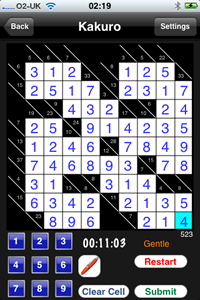The basics:
- The clue represents the sum of the numbers in the adjacent
block of empty cells
- The numbers 1 to 9 are used to fill the grid
- Each block may contain only one occurrence of a digit
So how is it solved? If you've come from sudoku, then you
have a head start. You will be using logic to seek out individual
numbers and you will be keeping track of "candidate" numbers in each
cell, just as you would in sudoku.
Candidates are the possible numbers that can go in cells. For
example, in a block of two empty cells, where the clue is 3 both
cells will have candidates of 1 and 2. With these small clues you
may see the solution straight away, but if not, you should note the
candidates in the cells.
It will have already become apparent that there is only one
possible combination for the solution to the clue 3: 1 and 2. The
same goes for 4 in two cells, which is 1 and 3. The clue 10 for a
four-cell block will produce 1, 2, 3 and 4 - no other combination
will work - and there are many more examples like these.
Combinations where there is only one outcome are very important to
kakuro solving and I have included
a table of them.
Making a Start
Let's look at a real kakuro. Where do
you start? Well, before we commence entering lots of candidate
numbers there is an important rule to learn. We have already learned
that there are some fixed combinations of numbers, such as 3 in two
= 1 and 2, 4 in two = 1 and 3. If two of these blocks intersect and
share a unique number then the point where they intersect must be
that common number. If we examine the puzzle, there are quite a few
of these fixed combinations:
- 3 in two = 1, 2
- 4 in two = 1, 3
- 7 in three = 1, 2, 4
- 16 in five = 1, 2, 3, 4, 6
Are there any combinations that intersect and share a unique
digit? Yes, look at the bottom row of Figure 1. Here the 4
intersects with the 3 in the central black square. They both share
the number 1 uniquely, so that must be the number that goes in the
cell that they both share. Before we move on to find some more of
these, it is important to remember that they must share the number
uniquely. For example, the 16 intersects with the top 4, but they
both contain 1 and 3, so the cell at the intersection could be
either 1 or 3 (but that fact may in itself be a help later on).
Back at our puzzle there are two more places where 3 and 4
intersect (Figure 2), so both of the intersecting cells resolve to
1. Having solved those three squares directly, there are now some
holes that can be filled as a result (Figure 3).
Reducing Combinations
Now we are into a phase of
reducing combinations. Look at the last cell of the block for the 7
in Figure 4. It can only be 1 or 4, but we also know that we need a
total of 10 to complete the 15 block that intersects with the last
cell of the 7 block in two. Making 10 with either a 1 or 4 in it
would give us either 1 and 9 or 4 and 6. The 1 and 9 combination
doesn't work, because the only other square available in that 15
block intersects with the 16 block where only 1, 4 or 6 are
available as candidates. So, it must be 4 and 6 and the 4 must be
the last digit in the 7 block. The remaining 6 can nosw complete the
15 block. We can also complete the 7 block with the remaining 1 to
complete the sum.
Locked Values
Tackling the 16 block in Figure 5, where
just two cells remain, we must make 5 from a 1 and a 4 - the only
digits remaining in that known combination. We can see that the
second cell cannot be a 1, because there is already a 1 in the 15
block - it's a locked value - so it must be 4. And we have solved
the 16 block.
All that remains in Figure 6 is the last number in the 15 block,
which must be a 7 to make up the sum, and then the 5 in the 12
block, which is proved by the sum of the 6 block. Job
done!
|



